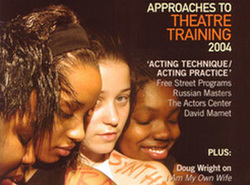Press
|
CNN Extra Effort Award
video segment In the Moment "Ron Bieganski believes it doesn't matter if his students choose acting for a profession, 'Figuring out what it takes to be an inspired human being, that's what they learn here." Extra cool fact - this segment was suggested to CNN by former student Brian Vines who was working there as an associate producer. American Theatre Magazine
How Do You Create Virtuoso Human Beings?:
article by Ron Bieganski Stillness is an Opening Our theatre training starts with the development of a nonjudgmental emotional openness and leads to whole human development. I've found that the more focused breath and movement work we do, the more the students open up to being intimate, immediate and spontaneous. The students have this inside them all the time -- what they need is a way to bypass the everyday process that closes them up, makes them self-conscious and think too much. So our acting training starts with this idea: Focus on your breath and whatever physical activity you are doing. As you focus on the breath and the activity, stillness emerges in your mind. No thought, negative or positive. As you focus on breath and activity, your heart opens and your body fills with emotion like a vase filling with water. Your breath is alive. Your body resonates like a violin with emotional breath. And yet there is stillness in your mind. Stillness is not nothing. It is an opening. |
A Year on Teen Street
Kartemquin documentary on WTTW "All it took was a soft breath in his ear." Kartemquin Films ("Hoop Dreams") spent a year following Free Street Theater, gaining access to the company's creative process and experience of its ensemble members. This special WTTW Artbeat presentation takes you from auditions to the performance tour of "Body House; a jazz tricycle" in Germany. PerformInk
A Simple Joyful Life - A Director's Training Approach
article by Ron Bieganski Clearing the Chaos After two decades of working with youth, it is still amazing to me how this creative work allows the student to grow in more ways than just as an actor. Our foundation work could be considered creating a "still point" in a chaotic composition. The one point that is silent allows all the other moving thoughts to be put in perspective. Like in a composition on stage when everything is always moving the audience gets dizzy, the stage is not easily understandable. If you stop one person from moving, all the other elements begin to make sense in relation to the still point. I have watched youth add this simple element into their daily life and everything becomes a little clearer for them. I see youth with such chaos in their lives and when they take the work we do and apply it to their own lives, I see them able to build, not destroy, the life they would like to live. I see youth discover they have a talent for a simple, joyful life. |
Chicago International Social Change Film Festival video
NeuroKitchen Summer Ensemble "I fell like when I got here I wasn't as strong mentally, physically or emotionally as I am at this moment. It pushed me to push myself." - Ensemble Member Alencia Norris "Community change starts with personal change. We're not developing youth. We're developing adults." - Director Ron Bieganski Just Playing the Part
"Just Playing the Part": Engaging Adolescents in Drama and Literacy
book by Christopher Worthman Keep Experimenting I believe in the part of my head where the top part opens up towards the heavens, growing towards the sun's rays. I believe in that line of melody that pulls that certain something out of my soul, leaving a pleasant ache. - TeenStreet, MadJoy My investigation into the creative process at TeenStreet, a community theater ensemble for teens, began with a focus on the ensemble's writing practices. I soon discovered, however, that these were more than writing, always tied to movement, improvisation, music, dance, talk, and reading of the teenage participants. To unravel all that - that bundle of interacting creativity - and to get only at the writing would have been to misrepresent the TeenStreet creative process. Thus this book is a critical literacy ethnography written, I hope, in the spirit of the ensemble it presents. |




